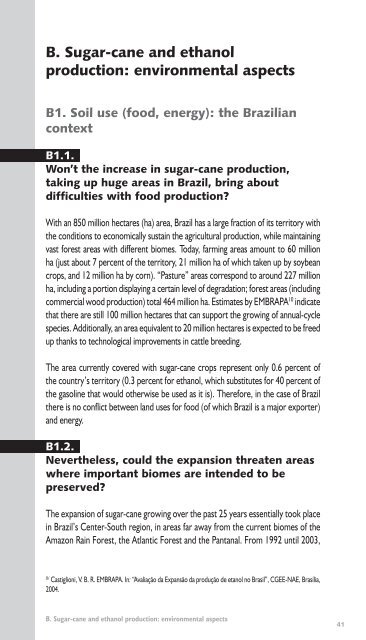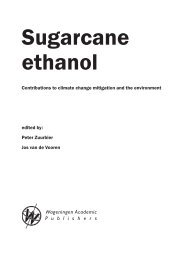Production and use of fuel ethanol in Brazil - BAFF
Production and use of fuel ethanol in Brazil - BAFF
Production and use of fuel ethanol in Brazil - BAFF
You also want an ePaper? Increase the reach of your titles
YUMPU automatically turns print PDFs into web optimized ePapers that Google loves.
B. Sugar-cane <strong>and</strong> <strong>ethanol</strong><br />
production: environmental aspects<br />
B1. Soil <strong>use</strong> (food, energy): the <strong>Brazil</strong>ian<br />
context<br />
B1.1.<br />
Won’t the <strong>in</strong>crease <strong>in</strong> sugar-cane production,<br />
tak<strong>in</strong>g up huge areas <strong>in</strong> <strong>Brazil</strong>, br<strong>in</strong>g about<br />
difficulties with food production?<br />
With an 850 million hectares (ha) area, <strong>Brazil</strong> has a large fraction <strong>of</strong> its territory with<br />
the conditions to economically susta<strong>in</strong> the agricultural production, while ma<strong>in</strong>ta<strong>in</strong><strong>in</strong>g<br />
vast forest areas with different biomes. Today, farm<strong>in</strong>g areas amount to 60 million<br />
ha (just about 7 percent <strong>of</strong> the territory, 21 million ha <strong>of</strong> which taken up by soybean<br />
crops, <strong>and</strong> 12 million ha by corn). “Pasture” areas correspond to around 227 million<br />
ha, <strong>in</strong>clud<strong>in</strong>g a portion display<strong>in</strong>g a certa<strong>in</strong> level <strong>of</strong> degradation; forest areas (<strong>in</strong>clud<strong>in</strong>g<br />
commercial wood production) total 464 million ha. Estimates by EMBRAPA 10 <strong>in</strong>dicate<br />
that there are still 100 million hectares that can support the grow<strong>in</strong>g <strong>of</strong> annual-cycle<br />
species. Additionally, an area equivalent to 20 million hectares is expected to be freed<br />
up thanks to technological improvements <strong>in</strong> cattle breed<strong>in</strong>g.<br />
The area currently covered with sugar-cane crops represent only 0.6 percent <strong>of</strong><br />
the country’s territory (0.3 percent for <strong>ethanol</strong>, which substitutes for 40 percent <strong>of</strong><br />
the gasol<strong>in</strong>e that would otherwise be <strong>use</strong>d as it is). Therefore, <strong>in</strong> the case <strong>of</strong> <strong>Brazil</strong><br />
there is no conflict between l<strong>and</strong> <strong>use</strong>s for food (<strong>of</strong> which <strong>Brazil</strong> is a major exporter)<br />
<strong>and</strong> energy.<br />
B1.2.<br />
Nevertheless, could the expansion threaten areas<br />
where important biomes are <strong>in</strong>tended to be<br />
preserved?<br />
The expansion <strong>of</strong> sugar-cane grow<strong>in</strong>g over the past 25 years essentially took place<br />
<strong>in</strong> <strong>Brazil</strong>’s Center-South region, <strong>in</strong> areas far away from the current biomes <strong>of</strong> the<br />
Amazon Ra<strong>in</strong> Forest, the Atlantic Forest <strong>and</strong> the Pantanal. From 1992 until 2003,<br />
0/ Castiglioni, V. B. R. EMBRAPA. In: “Avaliação da Expansão da produção de etanol no Brasil”, CGEE-NAE, Brasília,<br />
2004.<br />
B. Sugar-cane <strong>and</strong> <strong>ethanol</strong> production: environmental aspects<br />
41












